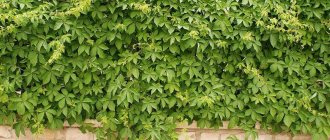Propagation of wild grapes
Propagation of wild grapes does not present any difficulties. As mentioned above, this grape spreads successfully by self-sowing. Root suckers and semi-lignified cuttings are also used for propagation. The cuttings are rooted in water or immediately laid flat in earthen grooves to a depth of no more than 2 cm, covered on top, trampled down and watered abundantly. If you do not allow it to dry out during this period, the cuttings will take root within 1 - 2 weeks. Young plants easily tolerate transplantation. If you purchased ready-made 1-2 year old seedlings, when planting them in a permanent place, ensure a distance between plants of at least 1 meter. A thick layer of sand and crushed stone drainage is laid at the bottom of a planting hole 40 - 50 cm deep, then the hole is filled with a mixture of garden soil, peat and sand, the seedling is compacted and sealed so that the root collar is at the level of the soil surface.
What are wild grapes?
Wild grapes are not a distant relative of the ordinary resident of private sectors or large vineyards. Another name is maiden, derived from the ability to form fruits without pollination. It is distinguished by the inedibility of its berries, its speed of growth, and its resistance to adverse weather conditions and chemical herbicides.
Once appearing on the site, wild grapes within a few years reach sizes of up to 30 meters along a separate vine. Growing in height, length, width, having the ability to produce abundant root shoots and rooting of separated parts, the plant covers the territory of the site, fences, and walls of rooms. For these reasons, as well as due to the density of greenery growth and its beautiful rich shade, it is often used as decoration.
The root system of an adult plant stretches for many meters, the shoots differ in thickness and wood density. The dark blue or purple berries are used as food by birds; they do not fall off for a long time; when they fall into the soil, they produce new shoots.
Incorrect feeding
Improper application of fertilizers often causes the death of entire vineyards. To avoid this, you should adhere to strict feeding rules.
First of all, you need to be careful with nitrogen. Its excess makes it difficult for the vine to ripen. This, in turn, leads to difficulties during wintering. Poorly matured shoots are prone to freezing or damping off (depending on the situation). Therefore, nitrogen fertilizers can be used only at the beginning of the growing season and in small doses.
In autumn you should not feed grapes with nitrogen.
For the same reason, all organic fertilizers are applied only in the spring. Then they will enable the plants to grow well, but will not interfere with their preparation for winter.
Cutting method
To breed wild grapes, you can use the cutting method, in which cuttings are used - sections of the vine that have 4 living, awakened buds. Cuttings are cut from the middle of the spring season until autumn. Before propagating wild grapes in the countryside using cuttings, select a woody vine from last year. It is recommended to take parts in the nodes of which there are barely noticeable rudiments of future roots. In the summer-autumn period, it is possible to cut hammer-shaped chibouks - young ones, with a small piece of the mother shoot. They are cut off when the bark at the base of the young shoot begins to become coarse. After preparing the planting material, it is planted in a permanent place. When propagating wild grapes from cuttings, follow this order:
- Prepare the place where the bushes will be located, the distance between which should be 2 meters. Mark the area with pegs or fence it off.
- Place a support under the grapes.
- Dig a hole 15 cm deep.
- Place drainage at the bottom of the recess - crushed stone, sand, expanded clay, broken brick to create good air permeability of the soil.
- The soil fertility will be increased by a mixture of humus and garden soil. Having fertilized the soil well, you will forget about the need to feed the vine for several years.
- Plant the cuttings in the ground slightly at an angle so that 2 buds are in the ground and 2 outside.
- Fill the hole with soil, tamp it down a little and water generously.
Further care of the cuttings consists of regular watering and weeding
Please note that above ground vines will develop slowly. First, the root system is formed. When the roots go 1 meter deep into the ground, the above-ground green mass will begin to develop intensively
When the grapes have developed sufficiently, they should be pruned regularly. Young shoots will need to be protected from frost. Gardeners recommend mulching plants. Don't forget to provide culture with support. Small buildings may not support the weight of the vine
When the roots go 1 meter deep into the ground, the above-ground green mass will begin to develop intensively. When the grapes have developed sufficiently, they should be pruned regularly. Young shoots will need to be protected from frost. Gardeners recommend mulching plants. Don't forget to provide culture with support. Small buildings may not support the weight of the vine.
Additional recommendations
The known practice of fighting roots is as follows:
- grape vines are cut at the base;
- in the places of cuts, holes 1-2 cm wide are drilled;
- the herbicide solution is drawn into syringes;
- The chemical is injected into the resulting holes through a needle or directly from a syringe.
Those who have overcome girlish grapes recommend that they be sure to pick and collect fallen berries, which produce a harvest of new shoots in the spring. Before starting cleaning work, it is advisable to remove debris and obstructions from the site, because roots and growth can hide under them. Underground parts can extend from nearby territories, so the fight will be useless without the connection of neighbors.
Wild grapes, with proper care and pruning, can become a good addition to the decor of a fence, gazebo or other room on the site. Therefore, sometimes an alternative to complete and long-term removal is to control plant growth.
In order not to think about how to get rid of wild vines in the future, when deciding to decorate your territory with climbing vines of greenery, consider all the pros and cons. Fighting the plant requires persistence and frequency. With their help, you can say goodbye to it in a few years or in a shorter time.
Wild grapes, also called virgin grapes, bring a lot of problems to the owner of the plot. If you are wondering how to get rid of wild grapes on your property, you should know that this is an extremely difficult process. The plant takes root well, is resistant to low temperatures and spreads over large areas. However, it is still quite possible to remove it if you put in some effort.
Herbicide treatment
Wild grapes are a very resistant plant to various influences. Many gardeners agree that in order to get rid of overgrowth, there is no way to do without herbicides. It will take a lot of time to completely eradicate the liana-like culture.
When treating with chemicals, you should generously water the base of the vine with a solution of herbicides based on the isopropylamine salt of glyphosate. You must first stock up on protective equipment (gloves, goggles, respirator). When performing manipulations, you need to make sure that the mixture does not get on useful crops. The most popular ready-made effective solutions:
Wild grapes are not so easy to grow in a country house or individual plot. Having a powerful root system, it produces significant young shoots. In addition to periodically exposing the plant to herbicides, digging up and removing the roots in the spring will be effective. To enhance the impact of chemicals, experts recommend covering the treated area with a film or opaque cloth and securely fixing it to the ground. This design is left for at least 14 days. Without access to air and sun, the plant dies faster.
When you decide to grow wild grapes in your dacha, you initially need to be patient. Digging up and removing rhizomes and treating the crop with chemicals can take up to two years before the plant can be completely eliminated.
As an alternative, you can use liana-like shoots for decorative purposes. By properly pruning and shaping the shoots, it is quite possible to create a beautiful frame for a gazebo, a specific area or area in your garden.
Roundup is an effective herbicide
Elimination of shoots
Initially, the fight against wild grapes begins with the elimination of elongated and tenacious shoots. All kinds of garden tools (secateurs, axes, hacksaws) will provide active assistance in this procedure. The best option would be to remove the main shoot, which is cut off at the base. Despite the seeming unreliability of the sprout, you will have to work hard, since the fibrous structure of the grapes is not so easy to mechanically influence.
Further stopping of shoots consists of eliminating and separating climbing shoots from their support. The likelihood that this operation will be quick and easy is unlikely. Having created intricate labyrinths, the plant strives to preserve at least some of them. Therefore, you will have to try to separate the shoots, trim them and get to the main root.
To permanently eliminate female shoots of wild grapes, you will need to get rid of all shoots, leaves and sprouts, which must be burned to prevent further restructuring. You can also benefit from clearing your area of wild grapes. If the cuttings are put in order and planted in planting pots, the plant can be sold to gardeners, many of whom grow this ornamental crop.
You need to remove all wild grape shoots, even the smallest ones.
How to propagate grapes by layering
Gardeners like to propagate wild grapes by layering, which is the most popular method. It attracts summer residents with its simplicity. When using this method, follow the instructions:
- Pre-dig a groove 5 cm deep near the mother plant.
- If the soil is poor, add humus and peat to the hole. The soil for planting must be loose.
- In the spring, when the buds swell or green shoots appear, select a healthy vine from the original plant and place it in the groove, without bending or straightening - freely, the way it grew. It's okay if part of the whip sticks out of the groove. Leave the leaves above the ground.
- Press the whip to the ground with wooden or metal pins (you can use hair pins), dig in, and water generously.
- The liana is cut off from the mother vine a year later in August-September and planted in a permanent place.
Summer residents prefer to grow grapes by layering, as this is the least labor-intensive process.
Maiden grapes - cultivation
Despite the fact that five-leaf grapes grow equally well in any place, it is still better to plant them on the sunny side. This way it will begin to grow faster, and the leaves will be larger and more picturesque in color.
Any time of year is suitable for planting “wild” grapes, but autumn is considered the most optimal. The soil requirements are minimal; any cultivated soil is suitable. The plant grows well on fertile loam with a neutral pH. Before planting, it is very important to build a permanent support for the fast-growing branches of the vine. It is not recommended to replant seedlings older than two years, so as not to disrupt the branching process.
Maiden grapes - planting:
- dig a hole measuring 60x60x60;
- fill 15 cm with drainage - crushed stone, broken brick, sand;
- mix a bucket of humus and half a bucket of sand with the removed soil;
- Place the seedling in the hole and cover it with soil;
- form a hole for irrigation so that the water does not spread.
The liana is so unpretentious that it easily reproduces by any means. Therefore, the problems “How to grow five-leafed virgin grapes?” does not exist.
- Propagation by seeds
Propagating a plant by seeds is quite troublesome, but in principle possible. Plant them in loose soil, deepening them one centimeter. Before sowing, grape seeds are soaked for 5 hours in cold water and then placed in the refrigerator for about a week. This method is rarely used.
- Propagation by cuttings
For rooting, it is better to take woody shoots from last year as thick as a pencil. In spring or early summer, cuttings 30 cm long with four to five healthy buds are cut. They are planted immediately at an angle in loose soil, leaving at least two green buds above the surface.
Be sure to water regularly until the plant begins to actively grow. The step between holes with cuttings is kept at one and a half to two meters. By the way, freshly cut cuttings take root well in a glass of water, and only then can they be planted.
- Reproduction by layering
A simple method of propagation by layering will require a minimum of effort. It is enough to spread a bunch of grapes on the ground, pin it with thick wire at the knots and sprinkle it with a little soil. During hot weather, the whip is watered. Next spring, the new plants formed from the sprinkled buds are divided, carefully digging out the roots, and planted.
- Reproduction by root suckers
It is very convenient to propagate grapes by root suckers, which are formed at the base of the bush as a result of the rapid growth of branches. They are easy to dig up and transplant to a new place for growing.
Folk remedies
How to water the ground so that the grass never grows or how to destroy the grass on the site forever - this question, of course, belongs to the realm of science fiction. Sooner or later, wind-borne seeds will again fall into the weed-free area and the weed will appear again. After all, everyone has seen how blades of grass grow even into asphalt cracks. What can we say about the fertile land on the dacha plot.
Nevertheless, folk wisdom and tricks allow you to get rid of weeds for a long time. Vinegar and regular table salt will help with this.
Salt against weeds
Salt allows you to get rid of the grass for a long time, but for a long period nothing will grow in this place at all. The method is used along fences and for clearing paths and paths.
Salt against weeds
The ground is sprinkled thickly with salt at the rate of kilograms per square meter. Salt should be added before rain or watering. Water or precipitation dissolves the salt and applies it to the ground.
All living things die and for many years nothing will grow in this place. This method was used in the old days as a means to permanently stop grass from growing in a cemetery. Removing the graves from grass took a long time.
Vinegar based composition
Vinegar helps get rid of unwanted grass no worse than modern herbicides and pesticides. A good and effective remedy to help a gardener or gardener is the following composition:
- liter of water;
- liter of acetic acid;
- alcohol 100 grams;
- two tablespoons of dishwashing detergent.
Drain everything into one container and spray the weeds with this mixture from a sprayer.
Care must be taken to ensure that the product does not come into contact with eyes or crops.
Important! Spraying should be done in the morning in calm weather. You can also sprinkle salt on the core of neatly cut weeds on the lawn or beds. The plant is cut at ground level and the cut is sprinkled with a pinch of salt.
The root remaining in the ground will definitely die. The method works great on burdock and dandelions
The plant is cut at ground level and the cut is sprinkled with a pinch of salt. The root remaining in the ground will definitely die. The method works great on burdock and dandelions
You can also sprinkle salt on the core of neatly cut weeds on the lawn or beds. The plant is cut at ground level and the cut is sprinkled with a pinch of salt. The root remaining in the ground will definitely die. The method works great on burdock and dandelions.
Effective ways to remove wild grapes
The first step in removing wild vegetation is removing the shoots. The owner of the site will have to spend a lot of effort to remove all the grape sprouts. In this case, various garden tools and devices are effectively used: pruning shears, a hacksaw or an ax. The best option is to remove the main shoot, which is located at the very base.
Then you will have to remove the sprouts that have curled and found support. The operation is labor-intensive, since the plant creates entire intricate labyrinths, trying to occupy as much free space as possible. It is necessary to separate all the shoots, cut them off completely and get to the main root. To completely destroy and eliminate its appearance in the future, you need to get rid of leaves, sprouts and all shoots.
Important! All removed parts of the plant should be burned immediately. After mechanical removal of sprouts and leaves, treatment with a chemical agent - herbicides - will be required.
It is not recommended to purchase too aggressive chemicals
After mechanical removal of sprouts and leaves, chemical treatment with herbicides will be required. It is not recommended to purchase too aggressive chemicals.
Having purchased the chemicals and necessary protective agents, you should treat the base of the grapes (vines) with a herbicide solution. During manipulation, care should be taken to ensure that the chemical solution does not come into contact with the growing crops. Effective drugs:
- Hurricane.
- Phenizan.
- Mitron.
- Pomegranate.
- Hermes.
Herbicide solutions can effectively kill a variety of annual and perennial weeds and shrubs. In this case, both above-ground and underground parts are removed. The results of the chemical can be seen within 20 days.
One of the drugs
Important! Excessively cold weather or drought may slow down the effect of the drug. Shrub processing must be carried out in dry and windless weather.
Then you cannot cultivate, weed or loosen the land for two weeks. It is advisable to cover nearby beneficial plants with plastic protective film before processing. Such chemical solutions do not affect seed germination, completely decompose in the ground and release carbon dioxide, water and phosphates
Shrub processing must be carried out in dry and windless weather. Then you cannot cultivate, weed or loosen the land for two weeks. It is advisable to cover nearby beneficial plants with plastic protective film before processing. Such chemical solutions do not affect seed germination, completely decompose in the ground and release carbon dioxide, water and phosphates.
The main danger of such a neighborhood is a powerful root system, which can produce a significant amount of young growth and destroy the cladding of buildings. Therefore, you should not only treat the plant with herbicide solutions from time to time, but also regularly dig up the soil and select the roots. As a rule, this method is used in the spring.
Advice! To enhance the effect of chemicals, it is recommended to hermetically cover the ground after treatment. Transparent film or fabric works great.
Such a shelter is made for two weeks. In such conditions, the plant will quickly die - without access to oxygen and direct sunlight.
During the first two years of active growth, wild vegetation grows to almost three meters in length. If you do not periodically clean the area, the vine reaches 30 meters in height. The growth and development of the vine must be constantly monitored and pruned. If it is possible to get rid of this plant, you can regularly give the grapes the appropriate shape and refine them.
A plant such as wild grapes has absolutely no useful purpose other than a decorative component. The winegrower will not be able to use it to make wine or simply eat it. As a result, this unwanted guest brings more negative influence and destruction. Removing wild grapes is not easy. But, having selected an effective remedy and knowing how to remove virgin grapes from the plot, you can get rid of them forever. The best option is manual action (trimming shoots and leaves, digging up the area and selecting roots) and subsequent chemical treatment.
1 2 votes
Article Rating
Top 5 methods for ridding your cottage of wild grapes
The greatest danger to large buildings and small structures comes from wild grapes.
The top 5 methods for ridding your dacha of this plant allows you to prevent its growth and reduce the negative impact on people’s real estate. The best methods involve treating the vines with special chemical compounds or non-toxic substances.
Harm from wild grapes
In most cases, owners of private houses and summer cottages consider wild grapes to be a harmful plant.
This is due to a large number of negative characteristics that can cause damage and create many problems.
Disadvantages of wild grapes:
- wraps around the walls of buildings and penetrates the cracks of the facade, gradually destroying them;
- the root system violates the integrity of the foundation;
- the vine is capable of clogging sewers and drains;
- the growth destroys the tiled surface and ground paths;
- slows down the evaporation of moisture from the soil, leading to the formation of mold and mildew;
- the vine prevents the growth of any plants;
- crumbled berries quickly rot, emit an unpleasant odor and attract harmful insects.
Methods of disposal
Summer residents have come up with several effective ways to combat harmful grapes.
All of them are simple, but they allow you to get rid of the vine for a long time.
Best methods:
- Manual removal . Before carrying out this procedure, you should protect your hands and exposed skin from contact with the vine. Then, using any available tool, separate the plant from a tree, bush or building wall. Using pruning shears, carefully cut the vine and immediately burn it.
- Mulching . For normal growth, wild grapes need a lot of light and air. By depriving it of this, you can quickly kill the plant. This can be done using mulch, which is better to use natural materials (grass, tree bark and others). In addition, the vine can be additionally covered with plastic film.
- Vinegar . To quickly get rid of a harmful plant, you need to prepare a solution. For it, take white vinegar and water in proportions of 1:4. The vine is sprayed with this mixture. After about 3 days, all that remains is to pull out the dead stems.
- Boiling water . Before using hot water, you need to dig up the roots of wild grapes. Then you should pour at least 1 liter of boiling water on them. As a result of such heat treatment, the root system will stop developing, and the plant will quickly begin to die.
Difficulties with the destruction of wild grapes on the site
Maiden grapes are a resilient plant, so you won’t be able to get rid of this unwanted “neighbor” right away. Despite the fact that the grape sprout seems thin and precarious, problems may arise with cutting it down.
Note! The tenacious plant has a wavy structure that is difficult to destroy mechanically. Most experienced gardeners and gardeners confirm the fact that the complete destruction of this wild crop is possible only with the use of chemicals
However, not every site owner will be able to afford to purchase herbicides. And also, in addition to chemicals, you will need to buy protective equipment - goggles, a respirator and gloves
Most experienced gardeners and gardeners confirm the fact that the complete destruction of this wild crop is possible only with the use of chemicals. However, not every site owner will be able to afford to purchase herbicides. And in addition to chemicals, you will need to buy protective equipment - goggles, a respirator and gloves.
Treatment with chemicals
It is also problematic to dig up the area and remove the roots, which may be located deep in the soil. Such a struggle can drag on for a long time. Sometimes land owners decide to plant wild grapes to form a beautiful hedge or gazebo, but end up regretting it.
Why remove wild grapes from the plot
Long vine shoots grow very deep into the soil, can clog drains, cut into the foundation of a house and tiles, and gradually destroy their integrity. Because of this, there may be a need for major repairs: changing the roof and plaster.
Wild grapes also have an impressive root system that easily interrupts the growth of other plants. It will be impossible to grow any crops nearby. Such a plant is not even suitable for viticulture. By learning how to get rid of wild grapes, you can significantly expand the area for truly necessary vegetables.
In addition, the plant is quite large in size and can create shade and retain moisture in the soil. As a result, mold and fungus very often develop in these areas - the main enemies of growing crops, which can lead to numerous diseases.
If you do not deal with this problem, after some time the entire garden will be covered with a real “carpet” of wild vegetation. And then the owner of the garden or cottage will not be able to cope with the unpleasant planting on his own.
Note ! Maiden grapes favor the spread of rodents and pests.
From time to time, the owner of the plot will be forced to pick berries growing on the grapes. This is necessary to prevent the plant from reproducing itself and the berries from rotting. You will regularly need to collect fallen leaves that pollute the land.
Interesting Facts
In order to prevent wild grapes from growing on your personal plot, you must carefully care for the area in which they grow. This is especially true for the issue of collecting fallen berries. This must be done in order to prevent the plant from reproducing on its own. Otherwise, wild grapes will easily stop the growth of other crops and grow to an incredible size, occupying a large area.
In addition, crumbled grapes quickly undergo rotting processes, which leads to the appearance of an unpleasant odor.
It is also necessary to pay attention to the active growth of wild grape shoots in order to prevent plants growing nearby, but not distinguished by such strength, from becoming unusable
Wild vineyard vines climbing along the walls of a residential building are able to penetrate cracks and crevices. Accordingly, the process of gradual destruction of the building begins there, because the shoots tend to expand, thereby increasing the deformation. An identical situation occurs when growths get under roofing materials.
Steady and strong vineyard growth results in shady areas as well as moisture retention. This leads to the development of fungal plaque and mold in such areas.
During the first two years, the vineyard reaches three meters in height. In the future, this figure may reach 25 meters. The growth activity of this type of grape requires constant adjustment and monitoring. They can be carried out with the help of timely pruning of the bush. If the plans include refining the plant, it is necessary to prune it to give the planting a certain shape.
In addition, you should first come up with a specific design, the purpose of which will be to support the weaving vines.
If such an event is ignored, wild grapes can grow into one huge green massif, which can easily drown out the development of all nearby crops.
The type of grape in question adapts to growth on any type of soil and under any climatic conditions, as well as lack of human attention. An interesting feature of this crop is that just before falling, the foliage can change color. Ripe grapes of a wild plant have a dark, rich color and may not fall off the vine even during leaf fall.
Wild grapes also have flowers that, with their greenish tint, are barely noticeable in the general foliage. The color palette of the leaves depends on the location where the vineyard grows. In sunny areas it will be much brighter than that of a plant in the shade. At the same time, shady wild grapes can boast of green foliage right up to the moment it falls.
An important fact is that, in addition to harm and use for decorative purposes, the wild vineyard has no practical purpose. Its berries, even ripe ones, are not used either in wine production processes, or, especially, for food production.
- Do you often experience pain and discomfort in your chest?
- It seems to you that your heart almost “jumps out” of your chest, then freezes for a while.
- you have shortness of breath even after minor physical activity.
- headaches, poor sleep, feelings of weakness and increased fatigue.
- In the evening my legs swell.
Good afternoon, I would like to share my experience with all readers. This year I decided to take a thorough approach to planting work. On the Internet, I came across an interview with Doctor of Agricultural Sciences Mikhail Valerievich Chursin. Inspired by the articles, I thought, why not use his recommendations, and, you know, I was right. I don’t know what to do with cucumbers and tomatoes anymore. Now I'm looking forward to the potato harvest. For those interested, here is a link to the article.
Materials: https://agronomam.com/vinogradarstvo/sorta-01/kak-vyvesti-dikij-vinograd.html
This is interesting: How to get rid of mushrooms on the lawn
Reviews and recommendations from gardeners
In practice, the opinions of gardeners on how to effectively eliminate wild grapes on a site coincide with the recommendations of experts. Everyone unanimously declares that getting rid of this plant is not easy, it will require patience, diligence and special treatment. If we summarize all the optimal methods for removing maiden grapes, we can highlight the following main methods:
- repeated application of a substantial portion of herbicides under the main root system of the plant;
- mechanical removal of roots with digging up the surrounding area;
- treating the area with products such as Roundam, Hurricane, Chistopol, Glyphosatine;
- clearing and forming shoots in the desired direction with periodic pruning.
Most gardeners advise not to even try to plant virgin grapes or hops in your garden plot. It grows quickly and is difficult to remove. Many gardeners, wanting to create a beautiful gazebo or part of the garden, regret that they decided to plant this plant.
It is worth noting that, apart from its decorative function and harm, wild grapes have no practical purpose. Its fruits are not used for winemaking or consumption. As the berries decompose, they create an unpleasant aroma, and the foliage, despite all its beauty, litters the surrounding area.
Having studied all the aspects of the growth and elimination of wild grape shoots, we can conclude that this plant does more harm than good. It should not be planted on the site. Because it is actively growing and impeding the development of other crops. Its removal is a rather labor-intensive and lengthy process. If you still decide to cultivate this crop, it is necessary to form shoots in a timely manner, remove excess shoots and collect fruits in order to avoid active reproduction of the liana-like crop.
Why plant
It happens that wild grapes appear suddenly and out of nowhere on a plot. These birds scatter seeds around. But more often it is planted quite deliberately for beauty and benefit.
Any look is suitable for beauty. Particularly decorative is the variety of girlish grape “Star Showers” with marbled white-green leaves, which at the end of the season changes to a mosaic of different shades of pink and red.
As for the benefits, wild varieties are indispensable for weaving fences that face streets with busy traffic.
This wall protects:
- from dust and wind;
- from noise;
- from someone else's annoying curiosity.
And it doesn’t matter at all what kind of land is under the fence - any culture is suitable. A particularly beautiful variety is Star Showers. A particularly beautiful Star Showers variety
A particularly beautiful Star Showers variety
The grapes are full of primitive wildness, vitality and power. Therefore, it is undemanding when it comes to fertilizers: if you don’t feed it, it will provide for itself. And so much so that without restrictive pruning, spreading over the surface of the earth and taking root, it is capable of capturing a huge space.
Characteristics of “wild” grapes
This plant does not have beautiful flowers or tasty fruits; its main value is its gorgeous green mass, which turns red in the sun or with the onset of long, cold nights. The leaves are five small leaflets fused at the base, which are attached to long petioles. Therefore, the vine is often called a five-leaf grape.
Why girlish? It’s just that flowers don’t need pollination, they are self-fertile. The resulting inedible dark blue fruits with a waxy coating are also very decorative. The plant is widely used for decorating unsightly building facades, landscaping gazebos, hedges and fences, and protecting attics or verandas from rain. The grapes are very durable: the vigor of shoot growth and the formation of dense foliage does not change even in extreme old age. In addition, it is not afraid of pests and diseases.
- forms a continuous canopy of greenery both in the shade and in the sun. It can reach a height of 25 meters, growing to 3 meters in the first two years;
- not afraid of frost, undemanding to moisture and soil composition;
- takes up little space while covering a large area;
- the plastic crown takes on various bizarre shapes, wrapping around a rigid frame;
- It reproduces easily, which can sometimes be a disadvantage.
Despite the obvious advantages of five-leaf grapes, many gardeners are wary of using it for landscaping their plots. And all because a lush vine, growing, can destroy the plaster on the walls of buildings, tiles or slate on the roof, and also clog the drainpipe. In addition, powerful roots behave aggressively, capturing soil space and penetrating into the foundation.
The shoots cling with tendrils with suction cups to the smallest roughness and defects on the surface, penetrating into any cracks. It's quite difficult to tear them off. Brick and stone foundations are suitable for landscaping, but wooden surfaces can become moldy due to high humidity. Fences made of “wild” grapes near a busy highway perfectly protect the house from harmful exhausts and dust, and muffle the sounds of the road.
Why do wild grapes harm the site?
If wild grapes grow in an area where there are no other plants, using them as an element of landscaping and decoration, you can not encounter negative characteristics for a long time. But over time, the following features are noticed:
- entwining the walls of buildings, the shoots of the plant are able to grow into the cracks of the facade, under the roof, destroying them, and the root system violates the density of the foundation;
- shoots can clog drains, sewers, and damage the integrity of ground paths and tiled surfaces if the direction of growth is not controlled;
- the grape cloth disrupts the processes of moisture evaporation from the soil, causing the formation of fungus or mold;
- growing other fruit crops and flowers becomes difficult or impossible, since roots and above-ground shoots block growth and the supply of nutrients;
- crumbling, the berries of the plant can become a source of rot and a specific smell.
The more wild grapes grow, the more difficult it is to control their growth or remove them from the area.
Ways to get rid of girlish grapes: effective and not so effective
There are many ways to combat maiden grapes, but not all of them give real results.
I was especially surprised by the advice actively replicated on the Internet to be sure to collect all its fruits. Maiden grapes have been growing in my garden for at least forty years now, they bear fruit almost every year, no one has ever harvested the fruits, but I have only found them self-seeding on the plot a couple of times in all this time.
Small fruits of virgin grapes, inedible for humans, are eaten by birds, but self-seeding in the garden is rarely found
It goes without saying that virgin grapes that have grown excessively in an unnecessary place have to be cut off at the root and uprooted, trying, if possible, to remove all the roots from the ground. Although this rarely gives a definitive result, especially if the roots have penetrated under the foundation, it helps to keep the vines under control.
It is often suggested to cover the place where the virgin grapes grew or are growing with some kind of dense opaque covering such as roofing felt or old carpets. Indeed, a relatively young plant can be completely destroyed in this way. Just not in a couple of weeks or months, as is usually advised, but in a couple of seasons.
If the vine thicket was especially powerful, like that of my long-suffering neighbor with her compost heap, then such covering of the surface can provoke active growth of roots to the sides underground, and a new vine shoot will eventually emerge a few meters away from the original place.
In the absence of support, the girl's grapes spread along the ground like a continuous green carpet
The only way to completely lime virgin grapes in any conditions is with a herbicide. Regular Roundup is quite suitable for this, but it must be used correctly. Contact herbicides of this type are most effective on young, actively growing leaves. Therefore, first, all the old shoots of virgin grapes must be cut flush with the ground and wait for the young shoots to appear
It is important to catch the moment while this shoot is still compact, so that neighboring plants are not damaged. To spray the herbicide, dry, windless weather is required. Rain occurring earlier than 12 hours after treatment will wash the chemical off the leaves and all efforts will be in vain.
When there are gusts of wind, splashes of herbicide can fall on other plants in the neighborhood and damage them.
Rain that has passed before 12 hours after treatment will wash the chemical from the leaves and all efforts will be in vain. When the wind gusts, splashes of herbicide can hit other plants in the neighborhood and damage them.
I use a regular small hand sprayer. In order not to bother myself with the problem of washing it, I have two of them: one for Roundup against weeds, the other for everything else for cultivated plants. In general, according to the rules, it is necessary to wear safety glasses, gloves and overalls when spraying, but I only make do with rubber gloves so as not to rub calluses on my hands with the sprayer.
After spraying with herbicide, wild grape shoots should be allowed to dry on the vine. There is no need to cut them off so as not to interfere with the spread of the chemical to the very roots. After a few months, new growth may appear, then spraying should be repeated. This is how, in a few steps, you can completely remove almost any weed with herbicide, including virgin grapes.
As you can see, it is quite possible to get rid of a girl’s grape that has grown in the wrong place, although this is not a very quick task and will require patience. Therefore, it is best to simply not plant this plant where it may cause problems later.
A fairly large area near the house is filled with girlish grapes.
The previous owners planted it under the windows. Then the house stood abandoned for several years. Yes, and I couldn’t get around to it. And now for the second year I’ve been trying to get rid of wild grape bushes, but I’m not succeeding. The girl's grapes strangled several currant bushes, knocked down a fence, made its way inside the terrace, spread several meters, crushing all the plants under itself. I poisoned him with Roundup, an agrokiller - he froze a little, then seemed to shake himself off - and grew again (( I cut him down - he was just rejuvenating. I read the advice that you need to inject with undiluted herbicide - it turned out to be unrealistic. Firstly, the needle cannot pierce woody stems . Secondly, there are a lot of stems, it is impossible to process them individually. After my actions, the monster became smaller, but still a lot. Please help me with advice on how to get rid of thickets of virgin grapes? And recently I was horrified when I saw seedlings of virgin grapes in a garden store grapes for 1000 rubles apiece. Good people, so I’m a millionaire :).
Possible problems from maiden grapes on the site and methods of preventing them
Maiden grapes are unpretentious, frost-resistant and grow very quickly. In autumn, its foliage takes on a luxurious bright red color, which is very helpful in detecting its shoots that have climbed into the wrong places.
Only thanks to the bright autumn colors of the leaves, I was able to discover in time that the girl’s grapes growing near my house had quietly spread to the nearest apple tree.
The grapes, of course, will not destroy an adult tree, but its spreading foliage during rapid growth will greatly shade the crown, which will significantly reduce the yield if the tree is fruit. Therefore, there is no place for grapes under fruit trees, neither virgin nor ordinary.
In autumn, the foliage of the maiden vine becomes bright red and noticeable from afar
The maiden grapes are fixed to the support with the help of branched tendrils at the ends of the shoots, which tightly cling to any unevenness. It takes a fair amount of effort to tear it off the branches of a tree or the wall of a house, simply breaking off the tendrils. With these tendrils, grapes often damage gutters and can damage the roof, especially in old houses.
Planting any grapes near the wall of a building is possible only under the condition of regular supervision and timely pruning of all shoots approaching the roof and gutters.
As it grows, the maiden grapes begin to spread out in all directions with the help of thick cord-like roots, stretching underground for many meters.
I have it growing near my house, always under supervision and regularly pruned. Therefore, I didn’t notice much spreading. But my neighbor got into trouble with this. She decided to decorate the compost heap located close to her garden with girl’s grapes. A few years later, the grapes, which had grown fat on the abundant diet, happily went into the garden. The neighbor has been fighting with him for ten years, but new shoots still appear from time to time - the bulk of the grape roots are comfortably located under a compost heap, which is completely built, with brick walls on cement mortar. At the same time, for some reason she refuses to use herbicide on principle, although she uses pesticides against pests and diseases quite actively.
To prevent such a situation, when planting virgin grapes, you must immediately limit the possible growth of its roots in the wrong direction by digging vertical sheets of old slate into the ground to a depth of about a meter.
Reproduction
How to propagate wild grapes? Cuttings are the easiest option. You can get planting material yourself in the forest belt and within the city, or ask your neighbors. Woody cuttings root best.
For planting you will need twigs with 3-5 healthy green buds. The choice should be made on a pencil-thin vine. The plant should be divided into segments of 20-30 cm with the required number of buds.
The prepared cuttings are placed in holes 8-10 cm deep and dug in so that 2 buds are underground and the rest are above it. The distance between plants should be 1.5 m. After planting, they must be watered. During the dry period, young grapes must be watered until active growth and development are noticeable. If the sun is too bright, it is recommended to build a shade over the planted cuttings.
Why are shoots harmful?
Sprouts quickly appear around plum trees. If you start the process, they will fill a significant area and occupy the garden bed. Both varietal and grafted specimens of fruit trees are susceptible to the phenomenon. The sprouting newly formed greens and the main plant have a single root system
To find out how to deal with emerging plum shoots, and how important it is, you need to understand that each shoot is continuously fed during the growing season. Due to the fact that the amount of substances consumed for development and growth is significant, the yield decreases
How to get rid of growth?
How to get rid of wild grapes: how to destroy and remove from the site
The problem of the appearance of huge thickets of wild grapes often appears on those household plots where vegetables and many other garden crops grow. The long size of the vine of this plant can cause clogged drains, destruction of the plaster and foundation, and destruction of the integrity of the finishing of a residential building.
The presence of an impressive root system allows wild grapes to stop the development of other plants with indescribable ease. Even a complete and painstaking study of the question of how to get rid of wild grapes will not give immediate results, since the culture does not want to give up the previously occupied territory of the site without a fight.
To carry out competent localization of the problem, it is necessary to follow a list of step-by-step measures that will allow you to remove wild grapes and prevent them from continuing to sprout.
Planting and care
Selecting a location
Wild grapes are quite picky, they do not need to be watered often and do not require a lot of fertilizer. Moreover, it is able to grow even in the shade. But still, it is better to choose a place for planting with a sufficient amount of sunlight - this will enhance the growth of the plant and the leaves will be larger. If planting will be carried out in weedy or rocky areas, then you need to prepare a planting hole about 50 cm deep and wide, then fill it with fertile soil mixed with humus. This filling will be enough for good intensive growth.
Although wild grapes have a large bush, the planting itself can be carried out in places that are completely unsuitable for other plants. The main thing to remember is that the rapid growth of a vine requires strong support so that the plant does not have any problems climbing to the top, so you need to think about this issue before planting.
How to plant wild grapes correctly
Planting a plant is a simple matter; the main thing is to follow a few rules.
Immediately before planting wild grapes, the hole is half filled with a soil mixture - fertile soil with humus. Then the plant itself lies down. If the soil is fertile and loose, you only need to prepare a hole where the roots will be freely distributed. The hole is filled with earth and watered with water.
At least one bucket of water is required for the first watering
It is important to check that the place of the seedling, where growth used to take place, is at ground level. If the vine turns out to be too deep, it will subsequently take a lot of effort and time to fight the active chaotic growth
If the soil along with the bush sank after watering, you need to pull the plant up a little, holding it by the base of the trunk near the ground
Then add more soil and water again. It should be borne in mind that planting a plant more than two years old is not recommended, since as a result the entire branching process is disrupted, and additional pruning will be required in order to properly form the bush.
Caring for wild grapes
Wild grapes are unpretentious. Removing weeds and loosening the soil from time to time is all that is required for maintenance. There is no need to water frequently. It is enough to water 3-4 times a season with 9-10 liters of water per bush.
Liana is a climbing plant, so it requires good support. The tendrils of grapes have an excellent ability to cling to the slightest uneven surface, so if the plant is planted near a fence or other structure, then no additional support is required. In addition, wild grapes on the fence look impressive.
Care at different times of the year
- Spring: In spring, grapes need to be cared for most responsibly. The subsequent development of the plant depends on the quality of work. When the snow melts, the plant needs to be inspected. Frozen, broken, or diseased branches are removed. Next, the old shoots are pruned to give the bush a more attractive appearance. It is recommended to cut out about 80% of old branches, as well as young shoots from the previous year. Liana branches - perennial branches through which food passes - live for about 4-6 years. There is no need to touch them, they are the basis of the bush.
- Summer: Caring for grapes in the summer requires less effort, since this plant is decorative. Excess shoots growing from the same eye must be removed. Otherwise, they will spoil the entire harmony of the bush. The main shoots need to be tied up, and all weak and lagging branches must be removed. In June, the plant needs to be watered periodically, the soil should be loosened, and excessively overgrown weeds should be removed. All unnecessary greenery is also removed.
- Autumn: All experienced gardeners know that how carefully you prepare a plant for winter will determine its survival. First of all, you need to create comfortable conditions for both the buds and the vine so that they successfully survive the winter. Good watering will help the grapes survive harsh conditions. How often to water the bush depends on weather conditions. In general, in October you need to properly moisten the soil at least once. To maintain moisture, it is necessary to regularly loosen the soil. In most cases, there is no need to additionally insulate grapes, since they tolerate frost well without significant harm to themselves. But in central Russia, where winters are especially harsh and long, you can build a reliable shelter over the bush that will help preserve the roots of the plant.
Your personal gardening consultant!
Wild grapes are a plant that can be either an excellent decoration for a summer cottage or a real problem.
Without proper care, it grows, turning into impenetrable thickets. Its long lashes, curling along the walls of buildings, become clogged in gutters, penetrate into the smallest cracks under the roofing, and grow into the plaster of facades, gradually destroying it. A powerful root system occupies a fairly large area, therefore it is capable of gradually drowning out other plants planted in the neighborhood, especially if this is also supplemented by a dense carpet of shoots creeping along the ground and gradually taking root. Quite often, gardeners are faced with the problem of thickets of wild grapes when they acquire plots that have not been looked after for several years.
In this case, the question becomes especially relevant: how to deal with wild grapes in order to clear the area of them? It should be immediately warned that to achieve this goal, the gardener will need to spend a lot of time, effort and patience, since girlish grapes are very reluctant to give up previously captured territories. In general, the process of removing wild grapes from a plot can be divided into several stages.
Removing wild grape shoots
The fight against wild grapes begins with the destruction of long and tenacious shoots. To do this, stock up on garden tools (hacksaw, axe, pruning shears) and, first, try to get to the main stem of the plant to cut it off at the base. Despite the apparent flexibility and slenderness of the vine, this may take some time, since the structure of thick woody shoots is fibrous and does not immediately yield to the pressure of a tool.
Then try to carefully separate the shoots from the support on which they climb and the surrounding plants. At this stage you will need considerable patience, since especially tangled lashes will have to be untangled (or cut with pruners) by hand and separately from each other.
To destroy girlish grapes, all shoots, leaves and fruits must be collected from the site (or that part of it where the plant is no longer expected to be grown) and burned in order to avoid re-propagation, because its cuttings easily take root in the soil, and seeds from ripened fruits next year they are capable of producing young shoots.
Those who want to earn extra money by getting rid of wild grapes on their plot can prepare high-quality cuttings and, rooting them in separate pots, sell them as planting material, because there will always be a gardener who wants to use this plant in the design of their dacha.
How to destroy wild grapes on the site: herbicide treatment
Speaking about how to get rid of wild grapes in the country, many gardeners agree that it is impossible to do without treating the base of the plant with herbicides. And even with the use of modern aggressive drugs, it will take a considerable period of time to destroy the vine.
During the treatment process, the base of the grapevine is generously watered with a herbicide solution, one of the main active ingredients of which is the isopropylamine salt of glyphosate. The most famous among such drugs are Roundup, Hurricane, Glyphos, Dominator, etc. But before you fight wild grapes using a solution of one of the listed drugs, make sure that you have stocked up on protective equipment for working with chemicals, namely, you will need gloves and protective glasses. It is also important to ensure that, along with wild grapes, you do not poison beneficial plants located nearby, so you should avoid getting the solution on anything other than parthenocissus vines.
Since the rhizome of ornamental grapes is quite powerful, such treatments can be carried out throughout the season until young shoots stop growing from the roots located in the soil. In addition, digging up the area in the spring, removing at least part of the plant's roots, can be useful.
For greater effect, after applying the herbicide, the treated area is covered for two weeks with a special cover made of film or opaque fabric, which is firmly fixed to the ground. Thus, without access to sun and air, the plant dies much faster.
Be prepared that you will have to dig up and treat tenacious wild grape shoots with herbicides more than once. Sometimes it takes up to two years for the vine to be completely removed from the site. Therefore, if you are still thinking about how to get rid of wild grapes in your dacha, then, when starting this difficult task, first of all, be patient. And think about it, maybe if you cut off the old thickened shoots and start forming neat lashes, this plant will turn from dense thickets into a real pearl of your garden?











